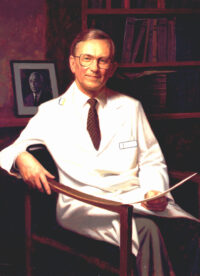Martin W. Donner Collection

Martin W. Donner
by Herbert E. Abrams
Collection Overview
Creator: Donner, Martin Walter (1920 - 1992)
Collection Date: 1949 - 1992
Extent: 65 linear feet
Biography
Martin W. Donner was born in Leipzig, Germany, and earned his M.D. at the University of Leipzig in 1945. Donner’s career at Johns Hopkins began in 1957, when he accepted a fellowship in radiology at the university. Until 1970, he devoted his efforts to researching the radiological aspects of gastrointestinal functions. In 1972, Donner became chief radiologist at the Johns Hopkins Hospital. His research, combined with his clinical and administrative abilities, helped him lead the department through three successive waves of technological advances in the imaging field–ultrasound, computerized tomography, and magnetic resonance imaging. Donner’s most far-reaching achievement, however, came with the effort he led to form a multidisciplinary, mutually cooperative research and clinical facility at Johns Hopkins to study and treat swallowing disorders. In 1986, he became the editor of Dysphagia, a journal that focuses on a multidisciplinary approach to swallowing disorders. Donner retired as chairman and director of the department of radiology in 1987 to devote his full attention to the swallowing center he had established.
Scope and Content
The Martin W. Donner Collection spans his entire career at Johns Hopkins, emphasizing his tenure as chairman of the department of radiology. Arranged in subject files, it consists of professional correspondence, committee records, speeches, student applications, patient records, manuscript notes, slides, and reprints. These records encompass Donner’s administration of the department of radiology at Johns Hopkins from 1972 to 1987, and they also document his interest in ultrasound, MRI, computerized tomography, and the treatment of swallowing disorders. Overall, the Donner collection chronicles an exceptional period of rapid advances in radiology, during which highly-developed technologies have produced remarkable new images of the human body and broadened the role of the radiologist in clinical medicine.
